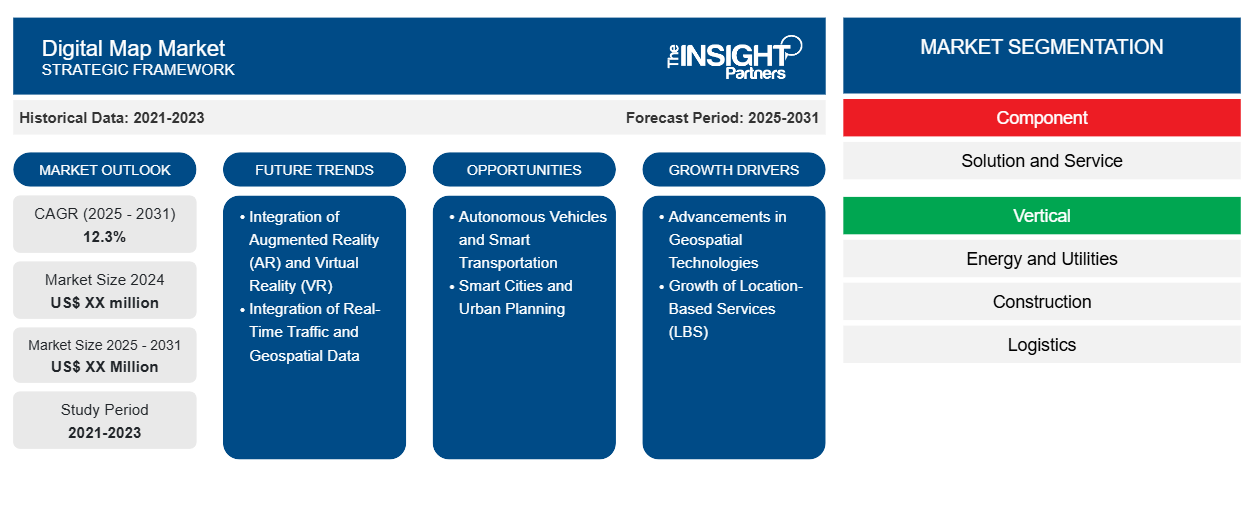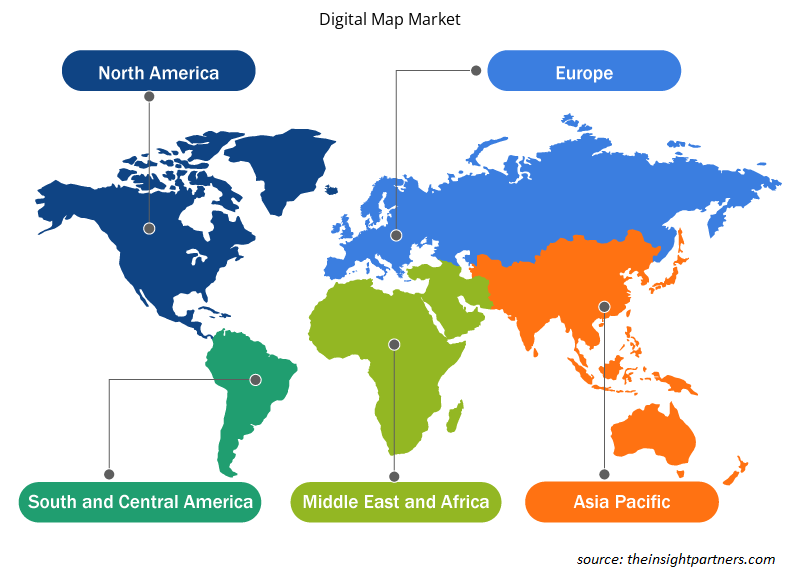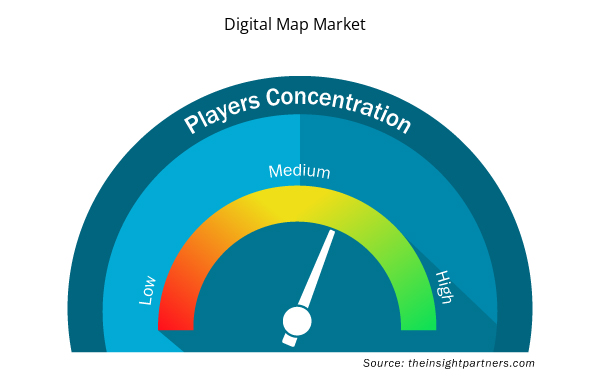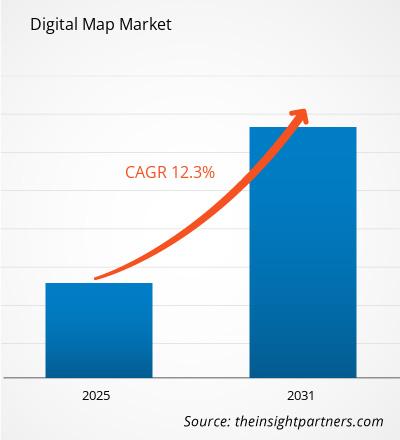من المتوقع أن يسجل سوق الخرائط الرقمية معدل نمو سنوي مركب بنسبة 12.3٪ من عام 2025 إلى عام 2031، مع توسع حجم السوق من XX مليون دولار أمريكي في عام 2024 إلى XX مليون دولار أمريكي بحلول عام 2031.
يُقسّم التقرير حسب المكونات (الحلول والخدمات) والقطاعات الرأسية (الطاقة والمرافق، والبناء، والخدمات اللوجستية، والحكومة والدفاع، والسيارات، وتجارة التجزئة). ويُفصّل التحليل العالمي بشكل أكبر على المستوى الإقليمي والدول الرئيسية. ويُقدّم التقرير القيمة بالدولار الأمريكي للتحليل والقطاعات المذكورة أعلاه.
غرض التقرير
يهدف تقرير "سوق الخرائط الرقمية" الصادر عن شركة "إنسايت بارتنرز" إلى وصف المشهد الحالي والنمو المستقبلي، وأهم العوامل المحفزة، والتحديات، والفرص المتاحة. وسيوفر هذا التقرير رؤى ثاقبة لمختلف أصحاب المصلحة في قطاع الأعمال، مثل:
- مزودي التكنولوجيا/المصنعين: لفهم ديناميكيات السوق المتطورة ومعرفة فرص النمو المحتملة، وتمكينهم من اتخاذ قرارات استراتيجية مستنيرة.
- المستثمرون: إجراء تحليل شامل للاتجاهات فيما يتعلق بمعدل نمو السوق، والتوقعات المالية للسوق، والفرص المتاحة عبر سلسلة القيمة.
- الهيئات التنظيمية: لتنظيم السياسات ومراقبة الأنشطة في السوق بهدف تقليل الانتهاكات والحفاظ على ثقة المستثمرين ودعم سلامة السوق واستقرارها.
تجزئة سوق الخرائط الرقمية
عنصر
- الحلول والخدمة
رَأسِيّ
- الطاقة والمرافق
- بناء
- الخدمات اللوجستية
- الحكومة والدفاع
- السيارات
- بيع بالتجزئة
قم بتخصيص هذا التقرير ليناسب متطلباتك
ستحصل على تخصيص لأي تقرير - مجانًا - بما في ذلك أجزاء من هذا التقرير، أو تحليل على مستوى الدولة، وحزمة بيانات Excel، بالإضافة إلى الاستفادة من العروض والخصومات الرائعة للشركات الناشئة والجامعات
سوق الخرائط الرقمية: رؤى استراتيجية

- احصل على أهم اتجاهات السوق الرئيسية لهذا التقرير.ستتضمن هذه العينة المجانية تحليل البيانات، بدءًا من اتجاهات السوق وحتى التقديرات والتوقعات.
عوامل نمو سوق الخرائط الرقمية
- التطورات في التقنيات الجغرافية المكانية: تُعدّ التطورات في التصوير بالأقمار الصناعية، ونظم المعلومات الجغرافية، والاستشعار عن بُعد، والذكاء الاصطناعي بمثابة المحركات الرئيسية لسوق الخرائط الرقمية. وقد أتاح نمو الحوسبة السحابية، إلى جانب القدرة على التعامل مع البيانات الضخمة آنيًا، إمكانية رسم خرائط رقمية عالية الدقة والتفصيل والانتشار. تُحسّن خوارزميات الذكاء الاصطناعي والتعلم الآلي تقنيات رسم الخرائط من خلال تحسين تحليل البيانات. سيسمح هذا بخرائط أكثر ذكاءً وديناميكية مع تنبؤات أفضل وتحديثات آنية. تجعل هذه التقنيات الخرائط الرقمية أكثر تفاعلية ودقة، وتوفر مجموعات بيانات أغنى وأكثر دقة للمستخدمين.
- نمو خدمات تحديد الموقع الجغرافي (LBS): يُعدّ ارتفاع خدمات تحديد الموقع الجغرافي أحد أهمّ العوامل المحفّزة لسوق الخرائط الرقمية. تُستخدم تطبيقات تحديد الموقع الجغرافي، مثل الملاحة وتحديد الموقع الجغرافي والإعلانات القائمة على الموقع، في مختلف القطاعات، بما في ذلك تجارة التجزئة والرعاية الصحية والخدمات اللوجستية والنقل. وتتزايد استخدام الخرائط الرقمية في تطبيقات الملاحة المحمولة، مثل خرائط جوجل وخرائط آبل، وخدمات حجز السيارات مثل أوبر وليفت، لتحسين تجربة المستخدم وزيادة الكفاءة. ومع نموّ الهواتف الذكية والأجهزة المتصلة، يتزايد الطلب على بيانات خرائط أكثر دقةً وفوريةً لتمكين هذه الخدمات.
اتجاهات مستقبل سوق الخرائط الرقمية
- دمج الواقع المعزز (AR) والواقع الافتراضي (VR): يُحدث الواقع المعزز والواقع الافتراضي تغييرًا سريعًا في طريقة استخدام الخرائط الرقمية وتجربتها. ويُدمج الواقع المعزز، على وجه الخصوص، مع الخرائط الرقمية لتوفير تجارب تنقل غامرة. على سبيل المثال، تُعرض معلومات الموقع الجغرافي مباشرةً على العالم الحقيقي من خلال الهواتف الذكية أو النظارات الذكية. وتُستخدم هذه التقنية في قطاعات السياحة والتجزئة والملاحة، حيث تُمكّن المستخدمين من تلقي تعليمات آنية خطوة بخطوة، ومعالم، وإعلانات على أجهزتهم أثناء تنقلهم الفعلي. ومن خلال دمج الواقع المعزز مع الخرائط الرقمية، يُعزز هذا التفاعل والتفاعلية عند التعامل مع العملاء في الشركات.
- دمج بيانات حركة المرور اللحظية والمعلومات الجغرافية المكانية: يُعد دمج بيانات حركة المرور اللحظية والمعلومات الجغرافية المكانية في الخرائط الرقمية أحد الاتجاهات الرئيسية في سوق الخرائط الرقمية. ويتجلى هذا التوجه بشكل خاص في تطبيقات الملاحة، وأنظمة المركبات ذاتية القيادة، والبنية التحتية للمدن الذكية. فمن خلال دمج البيانات اللحظية لحالة حركة المرور، وإغلاق الطرق، وتحديثات الطقس، والحوادث مع بيانات الخرائط التقليدية، يمكن للخرائط الرقمية تقديم خدمات ملاحة أكثر دقة وديناميكية ووعيًا بالسياق. ويعزز هذا التوجه الاستخدام المتزايد للأجهزة المتصلة وأجهزة الاستشعار في المركبات، والبنية التحتية الحضرية، وتطبيقات الهاتف المحمول، مما يجعل التحديثات اللحظية والبيانات الجغرافية المكانية أكثر سهولة وتكاملًا في منصات الخرائط.
فرص سوق الخرائط الرقمية
- المركبات ذاتية القيادة والنقل الذكي: فتح ظهور المركبات ذاتية القيادة آفاقًا جديدة في سوق الخرائط الرقمية. تحتاج السيارات ذاتية القيادة والطائرات المسيرة إلى خرائط دقيقة ومحدثة للتنقل بأمان، إذ تعتمد على نظام تحديد المواقع العالمي (GPS) وبيانات المستشعرات لتفسير محيطها. تُعد الخرائط عالية الدقة (HD) المزودة ببيانات آنية أمرًا بالغ الأهمية لتمكين المركبات ذاتية القيادة من فهم محيطها، وتحديد العوائق، واتخاذ القرارات. ومع استمرار استثمار صناعتي السيارات والنقل في تقنيات القيادة الذاتية، سيلعب مزودو الخرائط الرقمية دورًا هامًا في تطوير البنية التحتية اللازمة لدعمها. كما ستعزز الخرائط الرقمية المدمجة مع أنظمة النقل الذكية كفاءة شبكات النقل وسلامتها.
- المدن الذكية والتخطيط الحضري: تُعدّ المدن الذكية فرصةً كبيرةً أخرى لسوق الخرائط الرقمية. إذ يشهد معدل التحضر تزايدًا مستمرًا، ومعه يعتمد مخططو المدن والحكومات المحلية بشكل متزايد على الخرائط الرقمية لتحسين بنيتهم التحتية الحضرية، وإدارة الموارد، وتحسين الخدمات مثل النقل العام، وإدارة حركة المرور، وشبكات المرافق. تُمكّن أنظمة المعلومات الجغرافية وأدوات رسم الخرائط الرقمية من نمذجة المدن بدقة، مما يسمح لأصحاب المصلحة بتحليل الكثافة السكانية، واستخدام الأراضي، وأنماط حركة المرور، والأثر البيئي. ومع تزايد ترابط المدن واعتمادها على البيانات، سيستمر الطلب على الخرائط الرقمية الديناميكية والفورية في النمو، مما يُتيح فرصًا جديدة للابتكار في تخطيط وإدارة المدن.
رؤى إقليمية حول سوق الخرائط الرقمية
قام محللو إنسايت بارتنرز بشرح شامل للاتجاهات والعوامل الإقليمية المؤثرة في سوق الخرائط الرقمية خلال فترة التوقعات. ويناقش هذا القسم أيضًا قطاعات سوق الخرائط الرقمية ونطاقه الجغرافي في أمريكا الشمالية، وأوروبا، وآسيا والمحيط الهادئ، والشرق الأوسط وأفريقيا، وأمريكا الجنوبية والوسطى.

- احصل على البيانات الإقليمية المحددة لسوق الخرائط الرقمية
نطاق تقرير سوق الخرائط الرقمية
| سمة التقرير | تفاصيل |
|---|---|
| حجم السوق في عام 2024 | XX مليون دولار أمريكي |
| حجم السوق بحلول عام 2031 | XX مليون دولار أمريكي |
| معدل النمو السنوي المركب العالمي (2025 - 2031) | 12.3% |
| البيانات التاريخية | 2021-2023 |
| فترة التنبؤ | 2025-2031 |
| القطاعات المغطاة | حسب المكون
|
| المناطق والدول المغطاة | أمريكا الشمالية
|
| قادة السوق وملفات تعريف الشركات الرئيسية |
|
كثافة اللاعبين في سوق الخرائط الرقمية: فهم تأثيرها على ديناميكيات الأعمال
يشهد سوق الخرائط الرقمية نموًا سريعًا، مدفوعًا بتزايد طلب المستخدمين النهائيين نتيجةً لعوامل مثل تطور تفضيلات المستهلكين، والتقدم التكنولوجي، وزيادة الوعي بمزايا المنتج. ومع تزايد الطلب، تعمل الشركات على توسيع عروضها، والابتكار لتلبية احتياجات المستهلكين، والاستفادة من الاتجاهات الناشئة، مما يُعزز نمو السوق.
تشير كثافة اللاعبين في السوق إلى توزيع الشركات العاملة في سوق أو قطاع معين. وتشير إلى عدد المنافسين (اللاعبين في السوق) الموجودين في سوق معين نسبةً إلى حجمه أو قيمته السوقية الإجمالية.
الشركات الرئيسية العاملة في سوق الخرائط الرقمية هي:
- معهد بحوث النظم البيئية (ESRI)
- توم توم
- جوجل
- صندوق الخرائط
- منتجات الخرائط الرقمية، المحدودة
إخلاء المسؤولية : الشركات المذكورة أعلاه ليست مرتبة بأي ترتيب معين.

- احصل على نظرة عامة على أهم اللاعبين الرئيسيين في سوق الخرائط الرقمية
نقاط البيع الرئيسية
- التغطية الشاملة: يغطي التقرير بشكل شامل تحليل المنتجات والخدمات والأنواع والمستخدمين النهائيين لسوق الخرائط الرقمية، مما يوفر صورة شاملة.
- تحليل الخبراء: تم تجميع التقرير على أساس الفهم العميق لخبراء الصناعة والمحللين.
- المعلومات الحديثة: يضمن التقرير أهمية الأعمال التجارية بسبب تغطيته للمعلومات الحديثة واتجاهات البيانات.
- خيارات التخصيص: يمكن تخصيص هذا التقرير لتلبية متطلبات العملاء المحددة وتلبية استراتيجيات العمل بشكل مناسب.
لذا، يُمكن أن يُساعد تقرير البحث حول سوق الخرائط الرقمية في تمهيد الطريق لفهم سيناريوهات الصناعة وآفاق نموها. ورغم وجود بعض المخاوف المُبررة، إلا أن فوائد هذا التقرير الإجمالية تفوق عيوبه.
- التحليل التاريخي (سنتان)، السنة الأساسية، التوقعات (7 سنوات) مع معدل النمو السنوي المركب
- تحليل PEST و SWOT
- حجم السوق والقيمة / الحجم - عالميًا وإقليميًا وقطريًا
- الصناعة والمنافسة
- مجموعة بيانات Excel



Report Coverage
Revenue forecast, Company Analysis, Industry landscape, Growth factors, and Trends

Segment Covered
This text is related
to segments covered.

Regional Scope
North America, Europe, Asia Pacific, Middle East & Africa, South & Central America

Country Scope
This text is related
to country scope.
الأسئلة الشائعة
Some of the customization options available based on the request are an additional 3-5 company profiles and country-specific analysis of 3-5 countries of your choice. Customizations are to be requested/discussed before making final order confirmation as our team would review the same and check the feasibility
The report can be delivered in PDF/PPT format; we can also share excel dataset based on the request
The major factors driving the digital map market are:
1. Advancements in Geospatial Technologies
2. Growth of Location-Based Services (LBS)
Integration of Augmented Reality (AR) and Virtual Reality (VR) is anticipated to play a significant role in the global digital map market in the coming years
The Digital Map Market is estimated to witness a CAGR of 12.3% from 2023 to 2031
1. ESRI
2. TOMTOM
3. Google
4. Mapbox
5. Digital Map Products, Inc.
6. Microsoft Corporation
7. Living Map
8. Automotive Navigation Data
9. Mapman
10. Digital Mapping Solutions
The Insight Partners performs research in 4 major stages: Data Collection & Secondary Research, Primary Research, Data Analysis and Data Triangulation & Final Review.
- Data Collection and Secondary Research:
As a market research and consulting firm operating from a decade, we have published and advised several client across the globe. First step for any study will start with an assessment of currently available data and insights from existing reports. Further, historical and current market information is collected from Investor Presentations, Annual Reports, SEC Filings, etc., and other information related to company’s performance and market positioning are gathered from Paid Databases (Factiva, Hoovers, and Reuters) and various other publications available in public domain.
Several associations trade associates, technical forums, institutes, societies and organization are accessed to gain technical as well as market related insights through their publications such as research papers, blogs and press releases related to the studies are referred to get cues about the market. Further, white papers, journals, magazines, and other news articles published in last 3 years are scrutinized and analyzed to understand the current market trends.
- Primary Research:
The primarily interview analysis comprise of data obtained from industry participants interview and answers to survey questions gathered by in-house primary team.
For primary research, interviews are conducted with industry experts/CEOs/Marketing Managers/VPs/Subject Matter Experts from both demand and supply side to get a 360-degree view of the market. The primary team conducts several interviews based on the complexity of the markets to understand the various market trends and dynamics which makes research more credible and precise.
A typical research interview fulfils the following functions:
- Provides first-hand information on the market size, market trends, growth trends, competitive landscape, and outlook
- Validates and strengthens in-house secondary research findings
- Develops the analysis team’s expertise and market understanding
Primary research involves email interactions and telephone interviews for each market, category, segment, and sub-segment across geographies. The participants who typically take part in such a process include, but are not limited to:
- Industry participants: VPs, business development managers, market intelligence managers and national sales managers
- Outside experts: Valuation experts, research analysts and key opinion leaders specializing in the electronics and semiconductor industry.
Below is the breakup of our primary respondents by company, designation, and region:

Once we receive the confirmation from primary research sources or primary respondents, we finalize the base year market estimation and forecast the data as per the macroeconomic and microeconomic factors assessed during data collection.
- Data Analysis:
Once data is validated through both secondary as well as primary respondents, we finalize the market estimations by hypothesis formulation and factor analysis at regional and country level.
- Macro-Economic Factor Analysis:
We analyse macroeconomic indicators such the gross domestic product (GDP), increase in the demand for goods and services across industries, technological advancement, regional economic growth, governmental policies, the influence of COVID-19, PEST analysis, and other aspects. This analysis aids in setting benchmarks for various nations/regions and approximating market splits. Additionally, the general trend of the aforementioned components aid in determining the market's development possibilities.
- Country Level Data:
Various factors that are especially aligned to the country are taken into account to determine the market size for a certain area and country, including the presence of vendors, such as headquarters and offices, the country's GDP, demand patterns, and industry growth. To comprehend the market dynamics for the nation, a number of growth variables, inhibitors, application areas, and current market trends are researched. The aforementioned elements aid in determining the country's overall market's growth potential.
- Company Profile:
The “Table of Contents” is formulated by listing and analyzing more than 25 - 30 companies operating in the market ecosystem across geographies. However, we profile only 10 companies as a standard practice in our syndicate reports. These 10 companies comprise leading, emerging, and regional players. Nonetheless, our analysis is not restricted to the 10 listed companies, we also analyze other companies present in the market to develop a holistic view and understand the prevailing trends. The “Company Profiles” section in the report covers key facts, business description, products & services, financial information, SWOT analysis, and key developments. The financial information presented is extracted from the annual reports and official documents of the publicly listed companies. Upon collecting the information for the sections of respective companies, we verify them via various primary sources and then compile the data in respective company profiles. The company level information helps us in deriving the base number as well as in forecasting the market size.
- Developing Base Number:
Aggregation of sales statistics (2020-2022) and macro-economic factor, and other secondary and primary research insights are utilized to arrive at base number and related market shares for 2022. The data gaps are identified in this step and relevant market data is analyzed, collected from paid primary interviews or databases. On finalizing the base year market size, forecasts are developed on the basis of macro-economic, industry and market growth factors and company level analysis.
- Data Triangulation and Final Review:
The market findings and base year market size calculations are validated from supply as well as demand side. Demand side validations are based on macro-economic factor analysis and benchmarks for respective regions and countries. In case of supply side validations, revenues of major companies are estimated (in case not available) based on industry benchmark, approximate number of employees, product portfolio, and primary interviews revenues are gathered. Further revenue from target product/service segment is assessed to avoid overshooting of market statistics. In case of heavy deviations between supply and demand side values, all thes steps are repeated to achieve synchronization.
We follow an iterative model, wherein we share our research findings with Subject Matter Experts (SME’s) and Key Opinion Leaders (KOLs) until consensus view of the market is not formulated – this model negates any drastic deviation in the opinions of experts. Only validated and universally acceptable research findings are quoted in our reports.
We have important check points that we use to validate our research findings – which we call – data triangulation, where we validate the information, we generate from secondary sources with primary interviews and then we re-validate with our internal data bases and Subject matter experts. This comprehensive model enables us to deliver high quality, reliable data in shortest possible time.

 احصل على عينة مجانية لهذا التقرير
احصل على عينة مجانية لهذا التقرير